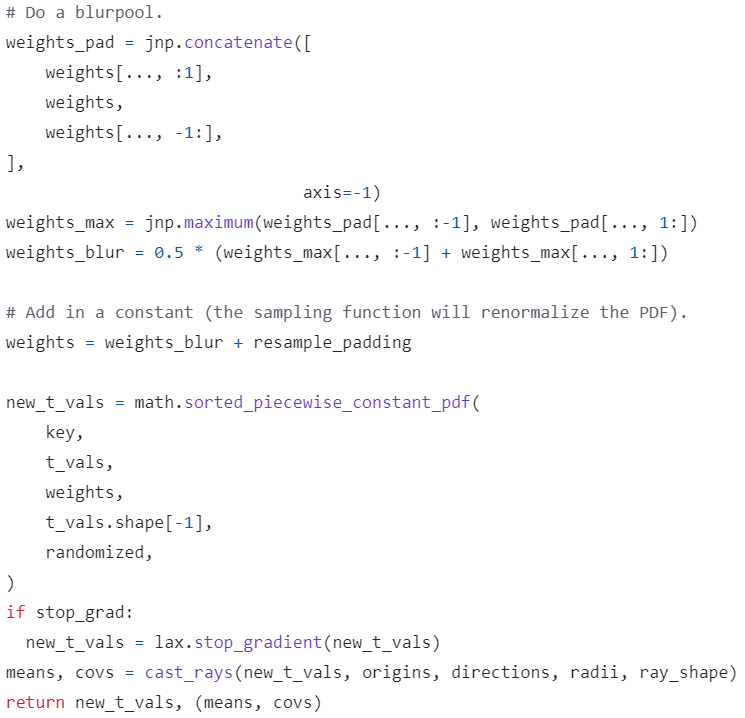MipNeRF
A Multiscale Representation for Anti-Aliasing Neural Radiance Fields
Mip-NeRF: A Multiscale Representation for Anti-Aliasing Neural Radiance Fields
Jonathan T. Barron, Ben Mildenhall, Matthew Tancik, Peter Hedman, Ricardo Martin-Brualla, Pratul P. Srinivasan
paper :
https://arxiv.org/abs/2103.13415
project website :
https://jonbarron.info/mipnerf/
pytorch code :
https://github.com/bebeal/mipnerf-pytorch
https://github.com/google/mipnerf
핵심 요약 :
- scale 잘 반영하도록 sample(region)을 pre-filtering!!
- ray-tracing하여 point-encoding 대신
cone-tracing하여 region-encoding 이므로
frustum의 모양과 크기 정보를 encode할 수 있어서 scale 반영 가능- IPE 단계에서
high variance (구간 길이가 일정하다면 distant view)일 때
high freq.를 attenuate(pre-filtering) 하여
임의의 continuous-space scale을 가지는 scene에 대해anti-aliasedrepresentation 학습 가능
\(\rightarrow\) multi-resolution dataset에 대해 성능 대폭 향상
\(\rightarrow\) scale-aware하므로single MLP하나만으로 충분하여 빠르고 가벼움- camera center로부터 각 pixel로 3D cone을 쏜 다음,
frustum을 multi-variate Gaussian으로 근사한 뒤,
Gaussian 내 좌표를 positional encoding한 것 (PE-basis-lifted Gaussian)에 대해
expected value \(E \left[ \gamma (x) \right]\) 계산
주의 : frustum이 Gaussian 분포를 따르는 게 아니라, frustum 내부의 mean, variance 값을 먼저 구한 뒤 해당 mean, variance 값을 갖는 Gaussian으로 frustum을 대신(근사)할 수 있다고 생각!
Introduction
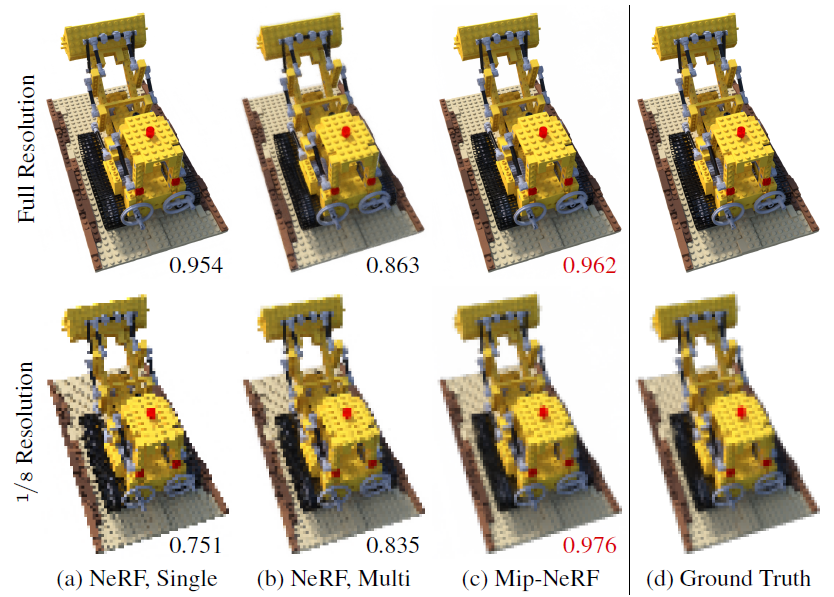
- 기존 NeRF의 문제점 :
- rendering 위해 sampling할 때
single rayper pixel 쏴서 composite 하므로
dataset에 있는 물체의 크기(resolution)가 일정하지 않을 때
multi-scales images에 대해 학습하더라도 -
blurryrendering inclose-upviews
(because 가까이서 찍어서 zoom-out하면 물체 inhigh resolution) -
aliased(계단) rendering indistantviews
(because 멀리서 찍어서 zoom-in하면 물체 inlow resolution) - 그렇다고 multiple rays per pixel through its footprint로 brute-force super-sampling(offline rendering)하는 것은 정확하긴 하겠지만 too costly 비현실적
- rendering 위해 sampling할 때
-
MinmapApproach :
classic 컴퓨터 그래픽스 분야에서 rendering할 때 aliasing을 없애기 위한pre-filtering기법
본 논문인 Mip-NeRF가 여기서 영감을 얻음
signal(e.g. image)을 diff.downsampling scales로 나타낸 뒤 pixel footprint를 근거로 ray에 사용하기 위한적절한 scale을 고른다
render time에 할 복잡할 일을 pre-computation phase에 미리 하는 것일 뿐이긴 하지만, 주어진 texture마다 한 번만 minmap을 만들면 된다는 장점이 있다

- Mip-NeRF :
- represent pre-filtered scene at
continuous space of scales - ray 대신
conical frustum사용해서anti-aliasedrendering with fine details - multi-scale variant of dataset에 대해 평균 error rate 60% 감소
- NeRF가 hierarchical sampling을 위해 coarse and fine MLP를 분리했다면, Mip-NeRF는
scale-aware하므로single multi-scale MLP만으로 충분
따라서 NeRF보다 7% 빠르고, param. 수는 절반이고, sampling도 더 효율적
- represent pre-filtered scene at
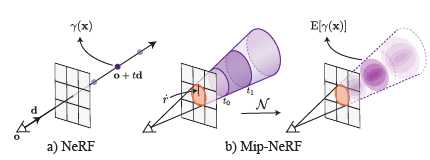
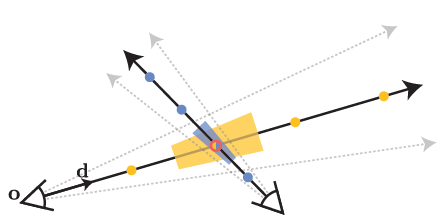
-
차이 : 기존 NeRF는
a single point를 encode하고, Mip-NeRF는a region of space를 encode -
기존 NeRF :
camera center로부터 각 pixel로 ray를 하나 쏜 다음 point sampling한 뒤 positional encoding
point-sampled feature는 ray가 보는volume의 모양과 크기를 무시하는 것임
예를 들어 training할 때 camera1로부터 t 사이의 간격이 평균 10cm로 학습된 scene에 대해
camera2로 inference를 할 때 t 사이의 간격이 평균 1cm로 sampling된다면
10개의 점은 같은 point-based feature를 갖게 되어 scale을 고려하지 못함
이러한 ambiguity가 기존 NeRF의 성능 하락의 요인 -
Mip-NeRF :
volume 정보를 반영하기 위해 camera center로부터 각 pixel로 3D cone을 쏜 다음, 3D point 및 그 주위의 Gaussian region을 encode하기 위해 IPE -
IPE (
integrated positional encoding) :
region을 encode하기 위한 방식
frustum을 multi-variate Gaussian으로 근사한 뒤,
Gaussian 내 좌표를 positional encoding한 것 (PE-basis-lifted Gaussian)에 대해 expected value \(E \left[ \gamma (x) \right]\) 계산
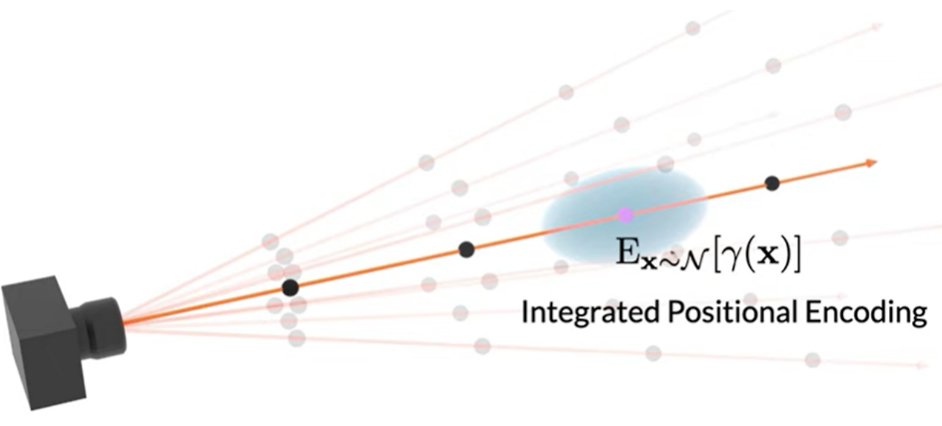
Related Work
Anti-aliasing in Rendering
anti-aliasing을 위한 고전적인 방법으로는 두 가지가 있다.
-
supersampling:- rendering할 때
multiple rays per pixel을 쏴서 Nyquist frequency에 가깝게 sampling rate를 높임 (super-sampling) -
expensiveas runtime increases linearly with the super-sampling rate, so used only inofflinerendering
- rendering할 때
-
pre-filtering:- target sampling rate에 맞춰서 Nyquist frequency를 줄이기 위해 scene에
lowpass-filter를 씌운 버전 사용 - scene을 미리
downsampling multi-scales(sparse voxel octree 또는 minmap)로 나타낸 뒤,ray 대신 cone을 추적하여 cone과 scene이 만나는 곳의 cone’s footprint에 대응되는 적절한 scale을 골라서 사용 (target sampling rate에 맞는 적절한 scale) - scene에 filter 씌운 버전을 한 번만 미리 계산하면 되므로, better for
real-timerendering
- target sampling rate에 맞춰서 Nyquist frequency를 줄이기 위해 scene에
그런데 아래의 이유로 고전적인 multi-scale representation은 적용 불가능
- input scene의
geometry를 미리 알 수 없으므로pre-filtering 할 수가 없어서
대신 pre-filtering 방식 자체를 training할 때 학습해야 한다- input scene의
scale이 continuous하므로 a fixed number of scales (discrete)과 상황이 다르다
\(\rightarrow\) 결론 : 따라서 Mip-NeRF는 training하는 동안, 임의의 scale에 대해 query 받을 수 있는, scene의 pre-filtered representation을 학습한다.
Scene Representations for View Synthesis
-
만약 images of scene are captured
densely라면, novel view synthesis 위해, intermediate representation of scene을 reconstruct하지 않고light field interpolation기법 사용 - 만약 images of scene are captured
sparsely라면, novel view synthesis 위해,explicit representationof the scene’s 3D geometry and appearance를 reconstruct-
polygon-mesh-basedrepresentation (discrete, classic) :
with either diffuse or view-dependent textures
can be stored efficiently, but mesh geometry optimization에 gradient descent를 이용하는 것은 불연속점 및 극소점 때문에 어렵 -
volumetricrepresentation :-
voxel-grid-basedrepresentation (discrete, classic) : deep learning으로 학습 가능, but 고해상도의 scene에는 부적합 -
coordinate-basedneural representation (continuous, recent) : 3D 좌표를 그 위치에서의 scene의 특징(e.g. volume density, radiance)으로 mapping하는 continuous function을 MLP로 예측- implicit surface representation
implicit volumetric NeRF representation
-
-
- 문제점 :
그동안 view synthesis를 할 때 sampling 및 aliasing에는 덜 주목했다
\(\rightarrow\)classic discreterepresentation의 경우 앞에서 소개한 minmap, octree와 같은 고전적인 multi-scale pre-filtering 기법을 쓰면 aliasing 없이 rendering 가능하다
\(\rightarrow\)coordinate-basedrepresentation의 경우 scale이 continuous하므로 고전적인 anti-aliasing 기법은 사용할 수 없다
\(\rightarrow\) sparse voxel octree 기반의 multi-scale representation으로 implicit surface의 continuous neural representation을 구현한 논문[1] 있긴 하지만, scene geometry의 priori를 알아야 한다는 제약이 있다
\(\rightarrow\) Mip-NeRF는 training하는 동안,임의의 scale에 대해 query 받을 수 있는, scene의anti-aliased (pre-filtered)representation을 학습한다.
Method
Cone Tracing and Positional Encoding
- Cone Tracing :
- Let \(d\) is cone direction vector from \(o\) to image plane
- Let \(\hat r =\) radius at image plane \(o + d\) \(= \frac{2}{\sqrt{12}}\) of pixel-width
so that image plane에서의 cone의 \(x, y\) 축 variance가 pixel’s footprint의 variance와 같아지도록
\(\hat r\)은 ray의 radius 변화율, 즉 frustum의 넓이를 결정 - \(t \in [t_0, t_1]\) 일 때 conical frustum 내의 \(x\)는 아래 범위의 값을 가질 때 indicator function \(F(x, o, d, \hat r, t_0, t_1)=1\)이다
\(F(x, o, d, \hat r, t_0, t_1) = 1 \left\{ (t_0 \lt \frac{d^T(x-o)}{\| d \|^2} \lt t_1) \land (\frac{d^T(x-o)}{\| d \| \| x-o \|} \gt \frac{1}{\sqrt{1+(\frac{\hat r}{\| d \|})^2}}) \right\}\)
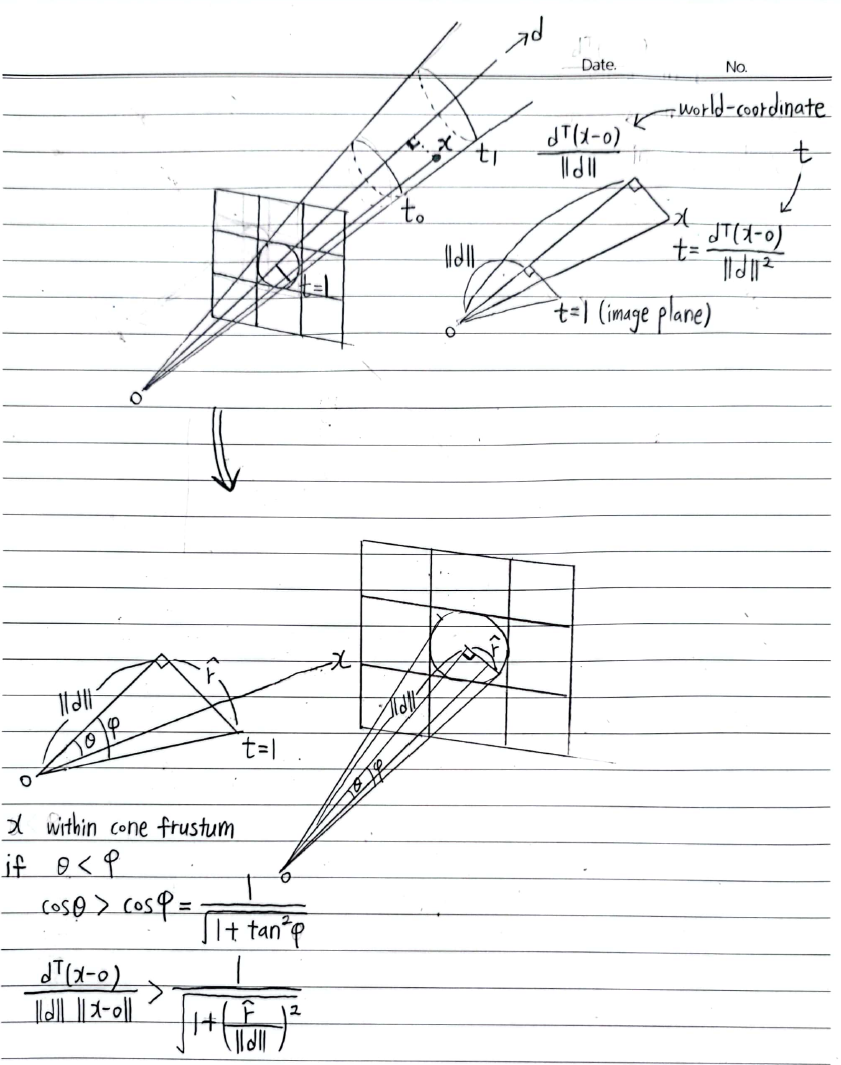
-
Region Encoding :
conical frustum 내에 있는 모든 좌표 \(x\)에 대해 직접
expected value \(E \left[ \gamma (x) \right] = \frac{\int \gamma (x) F(x, o, d, \hat r, t_0, t_1) dx}{\int F(x, o, d, \hat r, t_0, t_1) dx}\) 계산하면
region을 encode할 수 있는데
여기서 분자의 적분식은 closed-form solution이 없음
\(\rightarrow\) 직접 계산하지 말고
conical-frustum을 multi-variate Gaussian으로 근사한 뒤
Gaussian 내에 있는 모든 좌표 \(x\)에 대해
expected value \(E \left[ \gamma (x) \right]\) 계산 - frustum을 multi-variate Gaussian으로 근사 :
- conical-frustum 단면은 대칭적인 원이기 때문에
\(o, d\) 뿐만 아니라 아래의 3가지 정보만 알면 Gaussian을 특정할 수 있다-
mean distance along ray from o\(\mu_{t}\) -
variance along ray\(\sigma_{t}^2\) -
variance perpendicular to ray\(\sigma_{r}^2\)
-
- Let mid-point \(t_{\mu} = \frac{t_0+t_1}{2}\)
Let half-width \(t_{\sigma}=\frac{t_1-t_0}{2}\) - 아래 수식의 유도과정은 하위에 별도로 정리함
\(\mu_{t} = t_{\mu} + \frac{2t_{\mu}t_{\sigma}^2}{3t_{\mu}^2+t_{\sigma}^2}\)
\(\sigma_{t}^2 = \frac{t_{\sigma}^2}{3} - \frac{4t_{\sigma}^4(12t_{\mu}^2-t_{\sigma}^2)}{15(3t_{\mu}^2+t_{\sigma}^2)^2}\)
\(\sigma_{r}^2 = \hat r^2 (\frac{t_{\mu}^2}{4} + \frac{5t_{\sigma}^2}{12} - \frac{4t_{\sigma}^4}{15(3t_{\mu}^2+t_{\sigma}^2)})\) - 위의 3가지 param.를 가지는 Gaussian은
t-coordinate에서 정의했는데
아래 수식에 의해world-coordinate으로 변환할 수 있다
\(\mu = o + \mu_{t}d\)
\(\Sigma = \sigma_{t}^2(dd^T) + \sigma_{r}^2(I-\frac{dd^T}{\| d \|^2})\)
where \(dd^T =\) \(d\) 의 outer product은 \(d\) 방향으로의 투영을 의미하는 rank-1 matrix
where \(I-\frac{dd^T}{\| d \|^2}\) 는 \(\frac{d}{\| d\ \|}\) 와 수직인 subspace로의 투영을 의미하는 rank-2 matrix
- conical-frustum 단면은 대칭적인 원이기 때문에
- Integrated Positional Encoding (IPE) :
- 목표 : 위에서 계산한 \(\mu, \Sigma\) 의 Gaussian 내에 있는 모든 좌표 \(x\)에 대해 expected value \(E \left[ \gamma (x) \right]\) 계산
- 우선
PE (positional-encoding) basisP를 재정의
\(P = \begin{pmatrix} \begin{matrix} 1 & 0 & 0 & 2 & 0 & 0 \\ 0 & 1 & 0 & 0 & 2 & 0 \\ 0 & 0 & 1 & 0 & 0 & 2\end{matrix} & \cdots & \begin{matrix} 2^{L-1} & 0 & 0 \\ 0 & 2^{L-1} & 0 \\ 0 & 0 & 2^{L-1}\end{matrix} \end{pmatrix}^T\)
\(\gamma (x) = \begin{bmatrix} sin(Px) \\ cos(Px) \end{bmatrix}\) - \(E \left[ \gamma (x) \right]\) 는 expectation over \(\gamma (x) = \begin{bmatrix} sin(Px) \\ cos(Px) \end{bmatrix}\) 이므로
\(x\) in Gaussian of \(\mu, \Sigma\) \(\rightarrow\) \(\gamma (x)\) in Gaussian of \(\mu_{r}, \Sigma_{r}\) 로 변환해야 한다
즉,PE basis P로 lift한 뒤의 mean과 covariance를 구해야 한다
Since \(Cov[Ax, By] = A Cov[x, y] B^T\),
\(\mu_{r} = P \mu\)
\(\Sigma_{r} = P \Sigma P^T\) - 최종적으로 \(E \left[ \gamma (x) \right]\) , 즉
expectation over lifted multi-variate Gaussianof \(\mu_{r}, \Sigma_{r}\) 을 구하면 된다
Since \(E_{k \sim N(\mu, \sigma^2)}[e^{itk}] = exp(i \mu t - \frac{1}{2} \sigma^2 t^2)\) and \(sin(k) = \frac{e^{ik}-e^{-ik}}{2i}\) and \(cos(k) = \frac{e^{ik}+e^{-ik}}{2}\),
\(E_{k \sim N(\mu, \sigma^2)}[sin(k)] = sin(\mu)exp(-\frac{1}{2}\sigma^2)\) and \(E_{k \sim N(\mu, \sigma^2)}[cos(k)] = cos(\mu)exp(-\frac{1}{2}\sigma^2)\) for each axis-k
(positional-encoding은 각 dim.을 independently encode하므로 marginal distribution of \(\gamma (x)\) 에 의존)
\(\rightarrow\)
\(\gamma (\mu, \Sigma) = E_{x \sim N(\mu, \Sigma)} [\gamma (x)] = E_{Px \sim N(\mu_{r}, \Sigma_{r})} [\begin{bmatrix} sin(Px) \\ cos(Px) \end{bmatrix}]\)
\(= \begin{bmatrix} sin(\mu_{r}) \circledast exp(-\frac{1}{2}diag(\Sigma_{r})) \\ cos(\mu_{r}) \circledast exp(-\frac{1}{2}diag(\Sigma_{r})) \end{bmatrix}\)
where \(\circledast\) is element-wise multiplication - \(diag(\Sigma_{r})\) 만 필요하므로 \(\Sigma_{r}\) 전부 계산하지 말고
efficiently diagonal만 계산
PE-basis \(P\) 가 identity matrix이므로 \(diag(\Sigma)\) 만 필요
\(diag(\Sigma_{r}) = diag(P \Sigma P^T) = \left[ diag(\Sigma), 4 diag(\Sigma), \ldots , 4^{L-1}diag(\Sigma) \right]^T\)
where 3d-vector \(diag(\Sigma) = \sigma_{t}^2(d \circledast d) + \sigma_{r}^2(1-\frac{d \circledast d}{\| d \|^2})\)
diagonal만 직접 계산하면, IPE feature는 PE feature랑 비슷하게 cost 소모
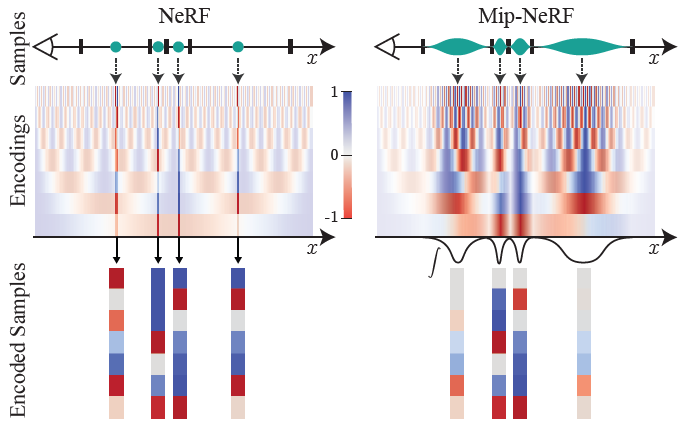
- IPE vs PE :
- PE :
point를 encode
0~L까지의모든 frequencies에 대해 동일하게encode
\(\rightarrow\)high-freq.PE features arealiased
(PE period가 interval width보다 작은 경우 PE over interval oscillates repeatedly) - IPE :
interval region을 integrate하여 encode
IPE feature를 만드는 데 사용된 interval \(t \in [t_0, t_1]\) width보다 period가 작은high freq.의 경우attenuate하여anti-aliasing
by \(exp(-\frac{1}{2}(\omega \sigma)^2)\) term - 위와 같은 특성 덕분에 IPE는 interval 내 공간의 모양과 크기를 smoothly encode할 수 있는 anti-aliased PE 기법이다!
- high freq.는 IPE 단계 자체에서 attenuate되므로
L을 hyper-param.로 두지 않고 extremely large fixed-value로 두면 된다
본 논문에서는 IPE feature의 last dim.이 numerical epsilon보다 작아지는 값인 \(L=16\) 으로 둠
- PE :
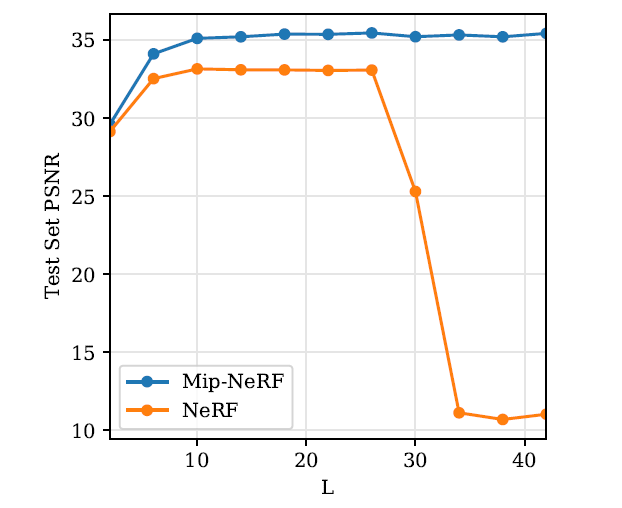
- IPE의 의미 :
이게 Mip-NeRF의 핵심!!- 수식 :
PE-basis P 는 다양한 frequency \(\omega\) 로 구성되어 있고
각 element는 \(E_{x \sim N(\mu, \Sigma)} [\gamma_{\omega} (x)] = sin(\omega \mu) exp(-\frac{1}{2}(\omega \sigma)^2)\) - distant view :
distant views (low-resolution), 즉 멀리 있는wide frustum(high variance \(\sigma\))의 경우에는
detail-info.(high freq. \(\omega\))는training에 사용하지 않겠다
\(\rightarrow\) more attenuation for high \(\sigma\) and high \(\omega\) - close view :
close views (high-resolution), 즉 가까이 있는narrow frustum(low variance \(\sigma\))의 경우에는
detail-info.(high freq. \(\omega\))를 training할 때 좀 더허용 - 위와 같이 scale을 반영할 수 있으므로 blurry 및 aliased rendering 문제 해결 가능!
- 수식 :
- 수식
Summary:- frustum을 근사하는 multi-variate Gaussian의 mean, variance \(\mu, \sigma\) 를 구한다
- PE-basis P로 lift한 Gaussian의 mean, variance \(\mu_{r}, \Sigma_{r}\) 를 구한다
\(P = \begin{pmatrix} \begin{matrix} 1 & 0 & 0 & 2 & 0 & 0 \\ 0 & 1 & 0 & 0 & 2 & 0 \\ 0 & 0 & 1 & 0 & 0 & 2\end{matrix} & \cdots & \begin{matrix} 2^{L-1} & 0 & 0 \\ 0 & 2^{L-1} & 0 \\ 0 & 0 & 2^{L-1}\end{matrix} \end{pmatrix}^T\)
\(\gamma (x) = \begin{bmatrix} sin(Px) \\ cos(Px) \end{bmatrix}\)
\(\mu_{r} = P \mu\) and \(\Sigma_{r} = P \Sigma P^T\) - \(E_{x \sim N(\mu_{r}, \Sigma_{r})} [\gamma (x)] = \begin{bmatrix} sin(\mu_{r}) \circledast exp(-\frac{1}{2}diag(\Sigma_{r})) \\ cos(\mu_{r}) \circledast exp(-\frac{1}{2}diag(\Sigma_{r})) \end{bmatrix}\)
(efficiently \(\Sigma_{r}\) 의 diagonal만 직접 계산)
\(diag(\Sigma_{r}) = diag(P \Sigma P^T) = \left[ diag(\Sigma), 4 diag(\Sigma), \ldots , 4^{L-1}diag(\Sigma) \right]^T\)
Conical Frustum Integral Derivation
-
우선
Cartesian-coordinate에서conical-coordinate으로 변환
\((x, y, z) = \varphi (r, t, \theta) = t \cdot (r cos \theta , r sin \theta , 1)\)
where \(\theta \in [0, 2 \pi)\) and \(t \geq 0\) and \(\| r \| \leq \hat r\)
Then,
\(dx dy dz = | det(D \varphi) | dr dt d\theta\)
\(= \begin{vmatrix} t cos\theta & t sin\theta & 0 \\ r cos\theta & r sin\theta & 1 \\ - rt sin\theta & rt cos\theta & 0 \end{vmatrix} dr dt d\theta\)
\(= (rt^2cos^2\theta + rt^2sin\theta) dr dt d\theta\)
\(= rt^2 dr dt d\theta\) -
conical frustum의 volume \(V = \int \int \int dx dy dz = \int_{0}^{2\pi} \int_{t_0}^{t_1} \int_{0}^{\hat r} r t^2 dr dt d\theta = \pi \hat r^2 \frac{t_1^3 - t_0^3}{3}\) 에 대해
conical frustum에서 uniformly-sampling한 points의probability density function은 \(\frac{rt^2}{V}\) 이다 -
t-axis:- \[E \left[ t \right] = \int_{0}^{2\pi} \int_{t_0}^{t_1} \int_{0}^{\hat r} t \cdot \frac{rt^2}{V} dr dt d\theta = \frac{3(t_1^4 - t_0^4)}{4(t_1^3 - t_0^3)}\]
- \[E \left[ t^2 \right] = \int_{0}^{2\pi} \int_{t_0}^{t_1} \int_{0}^{\hat r} t^2 \cdot \frac{rt^2}{V} dr dt d\theta = \frac{3(t_1^5- t_0^5)}{5(t_1^3 - t_0^3)}\]
-
x-axis(\(x = t r cos \theta\)) :- \[E \left[ t r cos\theta \right] = \int_{0}^{2\pi} \int_{t_0}^{t_1} \int_{0}^{\hat r} t r cos\theta \cdot \frac{rt^2}{V} dr dt d\theta = 0\]
- \[E \left[ (t r cos \theta)^2 \right] = \int_{0}^{2\pi} \int_{t_0}^{t_1} \int_{0}^{\hat r} t^2 r^2 cos^2 \theta \cdot \frac{rt^2}{V} dr dt d\theta = \frac{\hat r^2}{4} \frac{3(t_1^5 - t_0^5)}{5(t_1^3 - t_0^3)}\]
-
y-axis(\(y = t r sin \theta\)) :
conical frustum은 x, y에 대해 symmetric하므로 위에서 구한 x-axis에서의 값과 동일 - 이제 conical frustum 내부에 있는 random point에 대한 mean, covariance 값을 구할 수 있다
-
mean distance along ray from o:
\(\mu_{t} = E \left[ t \right] = \frac{3(t_1^4 - t_0^4)}{4(t_1^3 - t_0^3)}\) -
variance along ray:
\(\sigma_{t}^2 = E \left[ t^2 \right] - (E \left[ t \right])^2 = \frac{3(t_1^5- t_0^5)}{5(t_1^3 - t_0^3)} - \mu_{t}^2\) -
variance perpendicular to ray:
\(\sigma_{r}^2 = E \left[ x^2 \right] - (E \left[ x \right])^2 = \hat r^2 \frac{3(t_1^5 - t_0^5)}{20(t_1^3 - t_0^3)}\)
-
- 그런데 \(t_0, t_1\) 이 서로 가까우면 \(\frac{(t_1^5- t_0^5)}{(t_1^3 - t_0^3)}\) 과 같은 꼴은 numerically unstable as 0 or NaN instead of accurate values 이므로 training fail
\(\rightarrow\)
\(t_{\mu} = \frac{t_0+t_1}{2}\) and \(t_{\sigma}=\frac{t_1-t_0}{2}\) 로 re-parameterize하면
first-order term + correct(higher-order) term 꼴로 정리 가능하고
\(t_{\sigma}\) 가 작을 때에도 stable and accurate values 가짐- \[\mu_{t} = t_{\mu} + \frac{2t_{\mu}t_{\sigma}^2}{3t_{\mu}^2+t_{\sigma}^2}\]
- \[\sigma_{t}^2 = \frac{t_{\sigma}^2}{3} - \frac{4t_{\sigma}^4(12t_{\mu}^2-t_{\sigma}^2)}{15(3t_{\mu}^2+t_{\sigma}^2)^2}\]
- \[\sigma_{r}^2 = \hat r^2 (\frac{t_{\mu}^2}{4} + \frac{5t_{\sigma}^2}{12} - \frac{4t_{\sigma}^4}{15(3t_{\mu}^2+t_{\sigma}^2)})\]
-
limitation:
frustum의 base 반지름과 top 반지름 차이가 클수록
conical-frustum을 multi-variate Gaussian으로 approx.하는 건 inaccurate
(예를 들어, camera FOV가 클 때 camera center와 매우 가까운 frustum)
대부분의 dataset에서는 흔하지 않은 case이긴 하지만,
macro photography with fisheye lens와 같은 특별한 case에서 MipNeRF를 쓸 때는 frustum을 multi-variate Gaussian으로 approx.하는 게 문제가 될 수 있음
Architecture
- 아래 내용들을 제외하고는 NeRF의 Architecture와 동일
- ray-tracing 대신 cone-tracing
- PE 대신 IPE
- point-encoding 이므로 \(n\)개의 구간에 대해 \(n\)개의 point sampling
\(\rightarrow\)
interval(region)-encoding 이므로 \(n\)개의 구간을 위해 \(n+1\)개의 point sampling - PE feature로는 scale을 반영할 수 없으므로 두 가지 MLP (coarse-MLP, fine-MLP) 이용해서 hierarchical sampling
(coarse-MLP에서는 \(N_c=64\) points per ray, fine-MLP에서는 \(N_c+N_f=64+128\) points per ray)
\(\rightarrow\)
IPE feature 자체가 scale을 반영할 수 있으므로 MLP 하나를 반복해서 써서 hierarchical sampling
(한 번은 \(N_c=128\) points per ray, 그 다음은 \(N_f=128\) points per ray)
NeRF와 MipNeRF의 공정한 비교를 위해 같은 수(총 256개)의 point를 사용 - hierarchical sampling에서 piecewise-constant PDF of normalized \(w\) 에 따라 fine-sampling 하기 전에
weight \(w_k\) 를 바로 사용하지 않고
2-tap MaxBlur filter 를 적용하여 weight의 wide and smooth upper bound 를 사용
\(w_k^{\ast} = \frac{1}{2}(max(w_{k-1}, w_k) + max(w_k, w_{k+1})) + \alpha\)
where 빈 공간에서도 일부 samples 추출되도록 보장하기 위해 \(\alpha=0.01\) 설정

- MaxBlur filter :
- MaxPool 대신 MaxBlurPool 쓰면 aliasing 감소 효과
- MipNeRF에서 weight에 MaxBlur filter 쓰는 이유 :
scene content는 아무래도 연속적으로 존재하니까
인접한 samples 간의 weight \(w\) 가 갑작스럽게 변하거나 불연속적인 outlier 를 제외하여 smoothing 해주는 역할
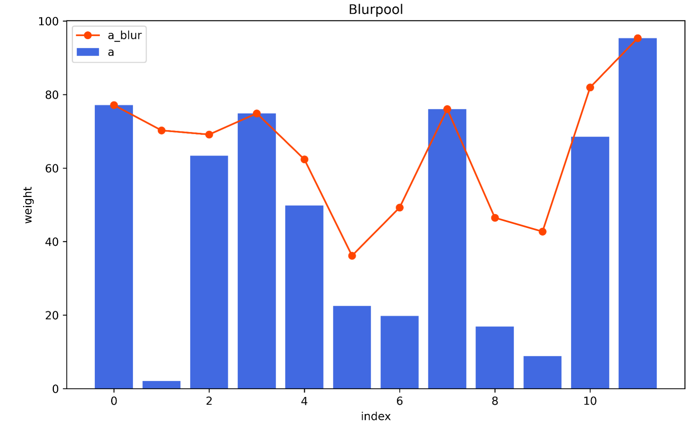
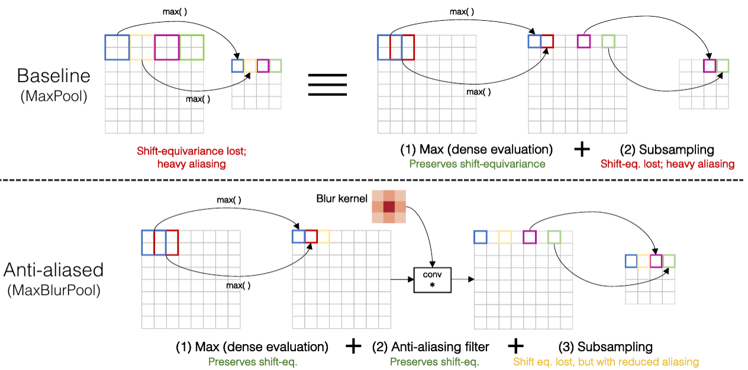
- Setting :
implementation on JaxNeRF
1 million iter., Adam optimizer, batch_size = 4096, lr from \(5 \cdot 10^{-4}\) to \(5 \cdot 10^{-6}\)
Result
- multi-scale dataset에 대해 NeRF보다 error rate 60% 감소
- single-scale dataset에 대해 NeRF보다 error rate 17% 감소
- NeRF의 param.의 절반이고, NeRF보다 7% 빠름
- brute-force super-sampling한 버전보다 22배 빠른데 accuracy 비슷
Question
- Q&A reference : 3DGS online study
- Q1 : distant view (scene content in low-resolution)일 때 IPE의 \(exp(-\frac{1}{2}(\omega \sigma)^2)\) term에 의해 high freq.를 attenuate하여 anti-aliasing 가능한 건 이해했는데,
close view (scene content in high-resolution)일 때 blurry rendering은 어떻게 해결?? - A1 : 위에서 “Method - Cone Tracing and Positional Encoding - IPE의 의미”에 설명해둠
- Q2 : image plane에서의 cone의 \(x, y\) 축 variance가 pixel’s footprint의 variance와 같아지도록
\(\hat r =\) radius at image plane \(o + d\) \(= \frac{2}{\sqrt{12}}\) of pixel-width 로 설정한다는데 이 부분이 이해가 되지 않습니다 - A2 : uniform distribution을 가정했을 때 pixel의 square variance는 \(\frac{w^2}{12}\) 이고, cone at image plane의 circle variance는 \(\frac{\hat r^2}{4}\) 이므로 variance 값이 같으려면 \(\hat r = \frac{2}{\sqrt{12}} \times w\)
- Q3 : \(E \left[ \gamma (x) \right] = \frac{\int \gamma (x) F(x, o, d, \hat r, t_0, t_1) dx}{\int F(x, o, d, \hat r, t_0, t_1) dx}\) 에서 분자의 적분식을 closed-form으로 계산할 수 없어서 conical frustum을 multi-variate Gaussian으로 근사했다는데,
conical frustum의 모양과 크기 범위에 대한 parameter가 주어진다면 frustum 내부의 점 \(x\) 에 sin 및 cos을 씌운 \(\gamma (x)\) 의 경우 \(x\) 에 대해 공간 적분할 수 있지 않나요? - A3 : frustum 내에 있는 모든 좌표에 \(\gamma\) 를 씌워서 공간 적분하는 것 자체가 말도 안 되게 복잡한 식이라 closed-form solution이 없기 때문에 frustum의 mean과 variance를 구해서 Gaussian으로 근사해서 expected value 구합니다
- Q4 : 논문을 보면 frustum을 multi-variate Gaussian으로 근사하기 위해서는 먼저 \(F(x, o, d, \hat r, t_0, t_1)\) 의 mean, covariance를 계산해야 한다고 쓰여있던데
appendix를 보면 indicator function인 F의 mean과 covariance가 아니라 conical frustum의 \(r, t, \theta\) 범위를 이용해서 공간 적분해서 \(t, x, y\) 축의 mean과 variance를 계산하지 않나요? - A4 : 맞습니다. 논문에서 \(F(x, o, d, \hat r, t_0, t_1)\) 의 mean, covariance를 계산해야 한다고 언급되어 있는 것은 단순히 frustum 내부 범위에 속해있는 지점에 대해 적분을 통해 mean, variance를 구해야 한다는 뜻인 것 같습니다.
- Q5 : NeRF에서 rendering할 때는 EWA volume splatting과 같은 좌표계 변환을 고려하지 않아도 되나요?
- A5 : NeRF에서는 ray를 따라 MLP의 output을 alpha-compositing하여 직접 pixel 값을 얻어내므로 ray를 쓰기 위해 cam-to-world coordinate 변환만 필요하고, projection에 의한 non-linear 좌표계 변환과는 관련이 없다.
반면, Gaussian Splatting에서는 rendering할 때 3D Gaussian 자체를 직접 projection해서 쓰기 때문에 3D Gaussian covariance matrix on world-coordinate을 2D Gaussian covariance matrix on image-coordinate (ray-space)으로 projection해야 하므로 non-linear 좌표계 변환이 필요하다. 이를 위해 EWA volume splatting에 따라 non-linear transformation을 Taylor approx.하여 local affine transformation으로서 Jacobian을 사용한다 - Q6 : camera origin과 pixel 중심을 잇는 ray가 image plane에 수직이 아닌 pixel의 경우 \(\hat r\) 과 \(d\) 를 어떻게 정의하지?
- A6 : \(d\) 는 camera origin부터 pixel 중심까지의 거리 vector이고,
cone 단면의 \(\hat r\)은 \(d\) 와 수직인 방향으로 \(\frac{2}{\sqrt{12}}\) of pixel-width 이므로
cone 단면이 image plane 위에 있지 않은 꼴이 됨
Appendix
TBD
Code Review
IPE (integrated positional encoding)
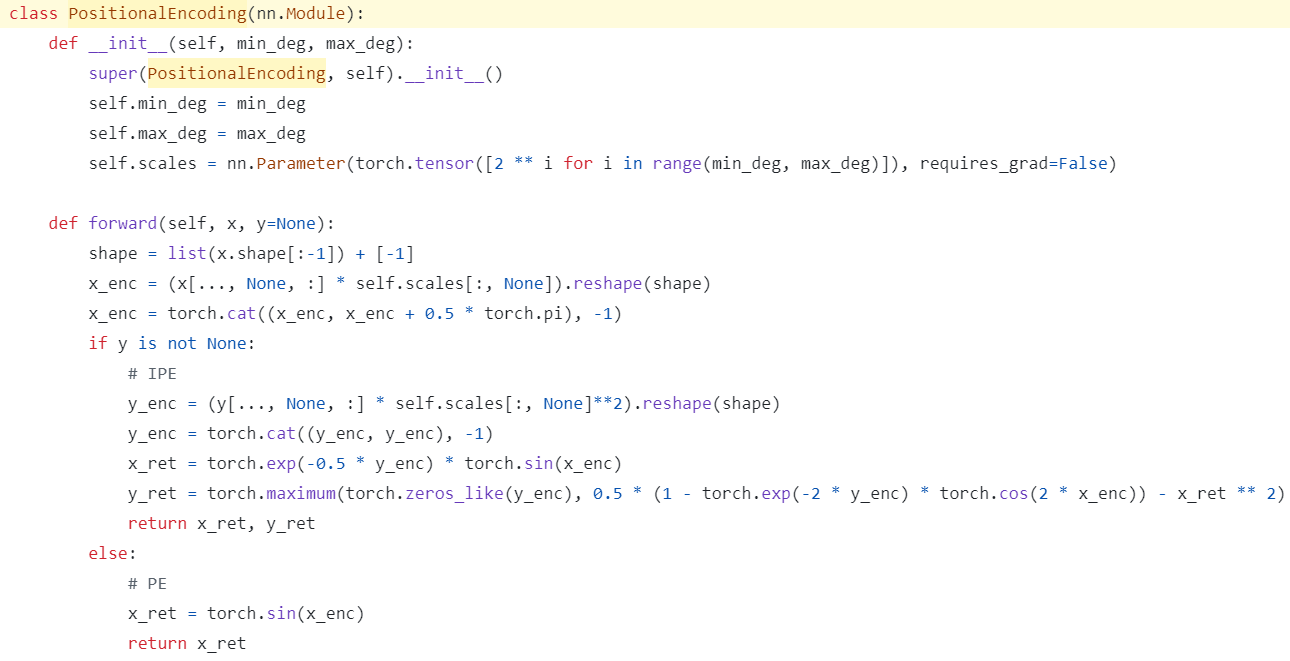
- self.scales : \([2^l, \ldots, 2^{L-1}]\) of shape (\(L-l\),)
- Let B : the number of cones
Let S : the number of samples (regions) (Gaussians) - case 1: Point-IPE
position은 Gaussian으로 근사해서 IPE 씀- x : \(\mu\) of shape (B, S, 3) and y : \(diag(\Sigma)\) of shape (B, S, 3)
- x_enc : \(\mu_{r}\) , 즉 PE-basis-lifted mean of shape (B, S, (\(L-l\)) * 6)
where 6 = 3 (3d-vector) * 2 (sin and cos)
\(\mu_{r} = P \mu = \begin{pmatrix} \begin{matrix} 1 & 0 & 0 & 2 & 0 & 0 \\ 0 & 1 & 0 & 0 & 2 & 0 \\ 0 & 0 & 1 & 0 & 0 & 2\end{matrix} & \cdots & \begin{matrix} 2^{L-1} & 0 & 0 \\ 0 & 2^{L-1} & 0 \\ 0 & 0 & 2^{L-1}\end{matrix} \end{pmatrix}^T \begin{bmatrix} \mu_{x} \\ \mu_{y} \\ \mu_{z} \end{bmatrix}\)
\(( \begin{bmatrix} \mu_{x} & \mu_{y} & \mu_{z} \\ \vdots & \vdots & \vdots \\ \mu_{x} & \mu_{y} & \mu_{z} \end{bmatrix} \circledast \begin{bmatrix} 2^l & 2^l & 2^l \\ \vdots & \vdots & \vdots \\ 2^{L-1} & 2^{L-1} & 2^{L-1} \end{bmatrix})\) .reshape(B, S, -1) \(= [\mu_{x}2^l, \mu_{y}2^l, \mu_{z}2^l, \ldots, \mu_{x}2^{L-1}, \mu_{y}2^{L-1}, \mu_{z}2^{L-1}]\) of shape ((\(L-l\)) * 3,)
where \(\circledast\) is element-wise multiplication
\(\cos{Px} = \sin{(Px + \frac{\pi}{2})}\) - y_enc : \(diag(\Sigma_{r})\) , 즉 diagonal of PE-basis-lifted covariance of shape (B, S, (\(L-l\)) * 6)
where 6 = 3 (3d-vector) * 2 (sin and cos)
\(diag(\Sigma_{r}) = diag(P \Sigma P^T) = \left[ diag(\Sigma), 4 diag(\Sigma), \ldots , 4^{L-1}diag(\Sigma) \right]^T\)
\(( \begin{bmatrix} \Sigma_{00} & \Sigma_{11} & \Sigma_{22} \\ \vdots & \vdots & \vdots \\ \Sigma_{00} & \Sigma_{11} & \Sigma_{22} \end{bmatrix} \circledast \begin{bmatrix} 4^l & 4^l & 4^l \\ \vdots & \vdots & \vdots \\ 4^{L-1} & 4^{L-1} & 4^{L-1} \end{bmatrix})\) .reshape(B, S, -1) \(= [\Sigma_{00}4^l, \Sigma_{11}4^l, \Sigma_{22}4^l, \ldots, \Sigma_{00}4^{L-1}, \Sigma_{11}4^{L-1}, \Sigma_{22}4^{L-1}]\) - x_ret : \(\gamma (\mu, \Sigma)\) of shape (B, S, (\(L-l\)) * 6)
\(\gamma (\mu, \Sigma) = E_{Px \sim N(\mu_{r}, \Sigma_{r})} [\begin{bmatrix} sin(Px) \\ cos(Px) \end{bmatrix}] = \begin{bmatrix} sin(\mu_{r}) \circledast exp(-\frac{1}{2}diag(\Sigma_{r})) \\ cos(\mu_{r}) \circledast exp(-\frac{1}{2}diag(\Sigma_{r})) \end{bmatrix}\) - y_ret (covariance of \(\sin{z}\) where \(z \sim N(x_{enc}, y_{enc})\) ) 은 안 씀
- case 2: View-Direction-PE
view-direction은 IPE 말고 그냥 PE 씀- x : view-direction of shape (B, S, 3) and y : None
- x_enc : \(Pd\) , 즉 PE-basis-lifted view-direction of shape (B, S, (\(L-l\)) * 6)
- x_ret : \(\gamma (d)\) of shape (B, S, (\(L-l\)) * 6)
\(\gamma (d) = \begin{bmatrix} sin(Pd) \\ cos(Pd) \end{bmatrix}\)
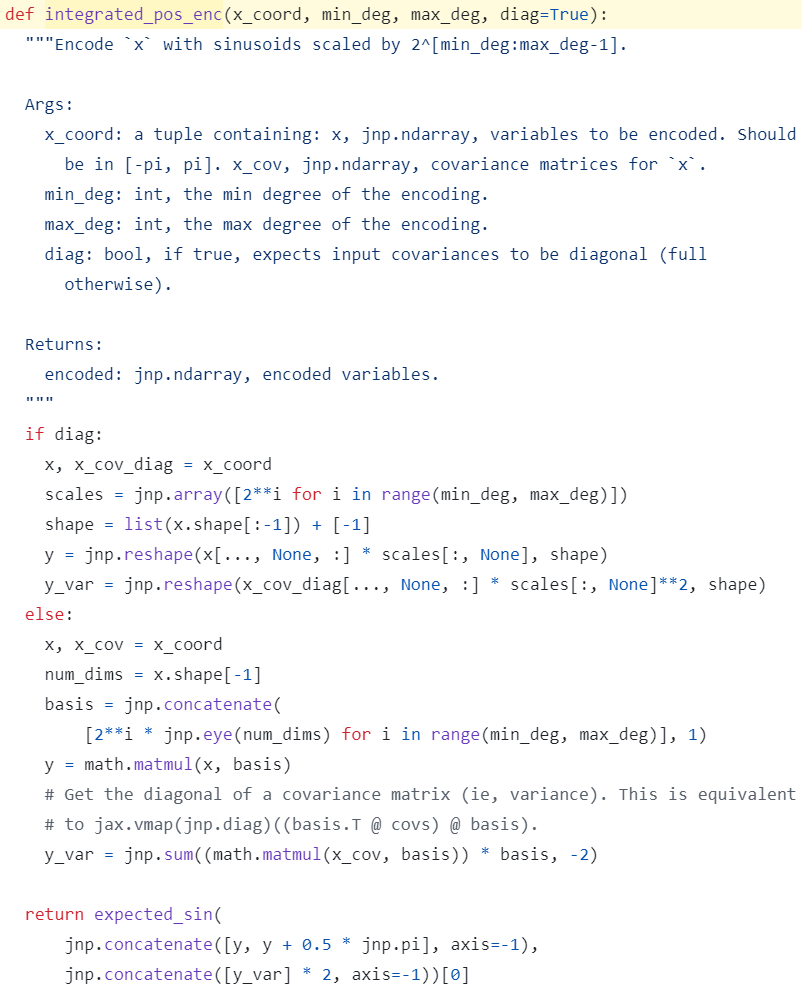

MaxBlur filter
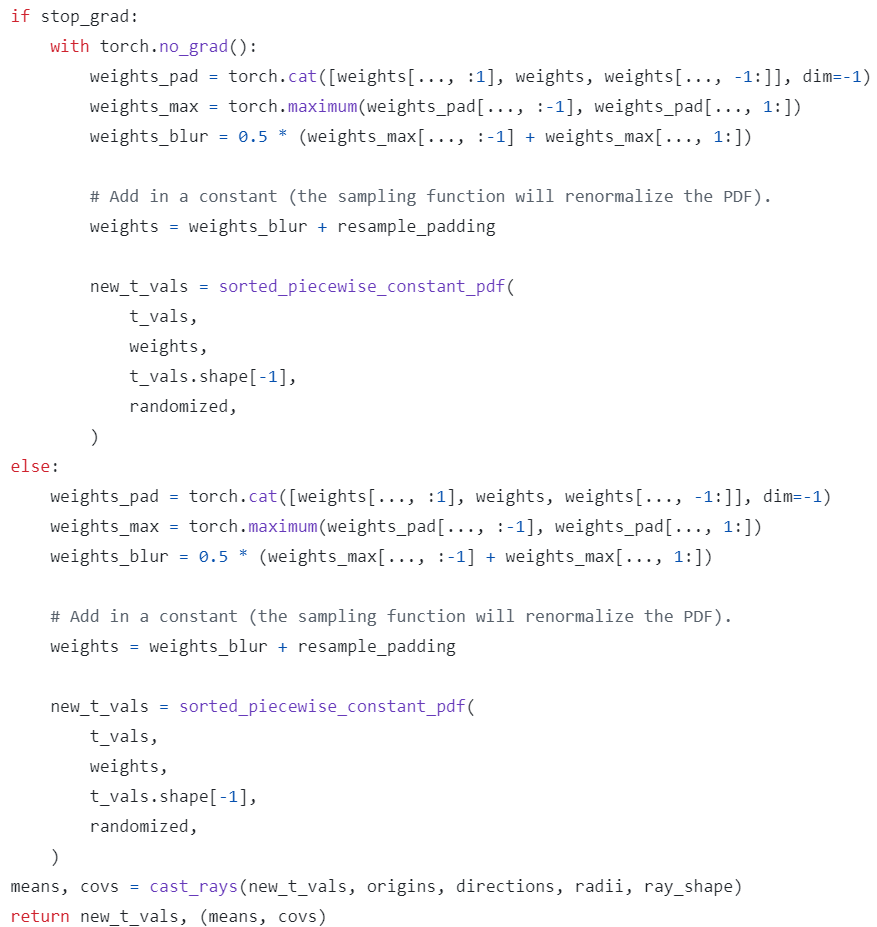
- \(w_k^{\ast} = \frac{1}{2}(max(w_{k-1}, w_k) + max(w_k, w_{k+1})) + \alpha\)
where 빈 공간에서도 일부 samples 추출되도록 보장하기 위해 constant \(\alpha=0.01\) 설정
